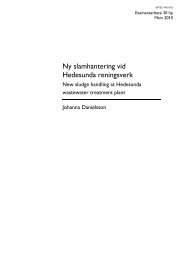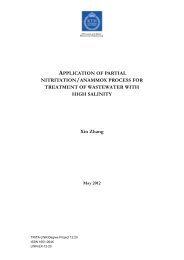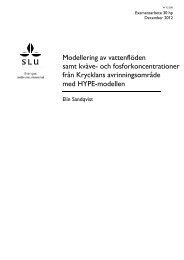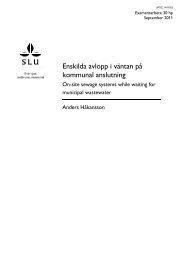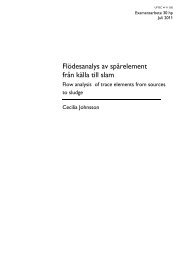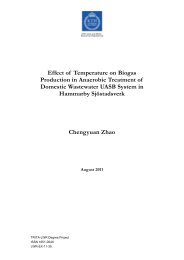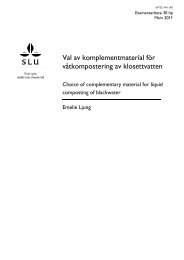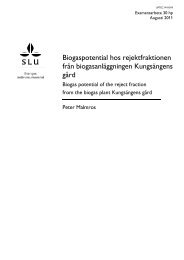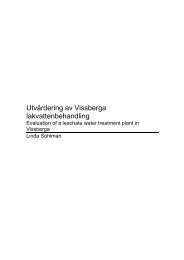Exergy saving and exergy production in municipal wastewater ...
Exergy saving and exergy production in municipal wastewater ...
Exergy saving and exergy production in municipal wastewater ...
You also want an ePaper? Increase the reach of your titles
YUMPU automatically turns print PDFs into web optimized ePapers that Google loves.
<strong>Exergy</strong> <strong>sav<strong>in</strong>g</strong> <strong>and</strong> <strong>exergy</strong> <strong>production</strong> <strong>in</strong> <strong>municipal</strong> <strong>wastewater</strong> treatment<br />
Energy value calculation for one gram COD from methanol:<br />
(Energy value) / (electron equivalent as e - ) = 41.88 kJ (38)<br />
(Electron equivalent as e - )/ (electron equivalent of (O)) =2 (39)<br />
(Electron equivalent)/ (g substance) =0.188 (40)<br />
(g substance)/ (g COD) = 0.67 (41)<br />
(Energy value)/ (g COD) = 10.6kJ/ (g COD) (42)<br />
Methane as electron donator:<br />
1/8 CO 2+H + +e - →1/8 CH 4+1/4 H 2 O 25.53 kJ/e - (43)<br />
1/4O 2+ H + +e - →1/2 H 2 O -78.72 kJ/e - (44)<br />
------------------------------------------------------------------------------------------<br />
1/8 CH 4+1/4 O 2→1/8 CO 2+1/4 H 2 O -53.19 kJ/e - (45)<br />
The reaction is thermodynamically possible consider<strong>in</strong>g the resulted<br />
negative value. The energy value of one gram COD of methane is:<br />
(energy value )/(electron equvalent as e - )= 53.19 kJ (46)<br />
(electron equivalent as e - )/(electron equivalent of (O) )=2 (47)<br />
(electron equivalent)/(g substance)= 0.5 (48)<br />
(g substance)/(g COD)= 0.25 (49)<br />
(energy value)/(g COD)= 13.3kJ/(g COD) (50)<br />
Accord<strong>in</strong>g to equations 42 <strong>and</strong> 50, the mean energy value of COD has<br />
been considered as 12 kJ/g COD (Fig. 2). However these values can be<br />
measured for other products depend<strong>in</strong>g on the dom<strong>in</strong>at<strong>in</strong>g substance <strong>in</strong><br />
the <strong>in</strong>flow of the facility. In the framework below the substrates fed <strong>in</strong>to<br />
a MFC can be based on for <strong>in</strong>stance glucose or acetate as nitrate <strong>and</strong> the<br />
energy value of 1 g of COD of these substrates can be measured as<br />
the above.<br />
Half reactions <strong>in</strong> the MFC conta<strong>in</strong><strong>in</strong>g glucose:<br />
(energy value)/(g COD) = 13.3kJ/(g COD) (51)<br />
6O 2+24H + + 24 e - →12 H 2O (52)<br />
------------------------------------------------------------------------------------------<br />
C 6 H 12 O 6+6O 2→6CO 2+6H 2O+electricity (<strong>exergy</strong>) (53)<br />
Half reactions <strong>in</strong> the MFC conta<strong>in</strong> acetate:<br />
CH 3COOH+2H 2 O→2CO 2+8H + +8e - (54)<br />
2O 2+8H + +8e - →4H 2O (55)<br />
------------------------------------------------------------------------------------------<br />
CH 3COOH+2O 2→2CO 2+ 2H 2O+ electricity (<strong>exergy</strong>) (56)<br />
Influent COD to the <strong>wastewater</strong> treatment plant <strong>in</strong> general configuration<br />
<strong>in</strong> advanced <strong>wastewater</strong> treatment, first goes through the aerobic <strong>and</strong><br />
anoxic processes for nitrification <strong>and</strong> denitirification processes. In case<br />
of phosphorous removal there will be anaerobic biological <strong>and</strong>/or<br />
chemical processes <strong>in</strong> the plant. F<strong>in</strong>ally, there will be anaerobic sludge<br />
digestion with the aim of biogas <strong>production</strong>. The rema<strong>in</strong><strong>in</strong>g COD which<br />
goes out from the treatment plant will be <strong>in</strong> two forms: either as <strong>in</strong>ert<br />
COD <strong>in</strong> the effluent or as dewatered digested sludge.<br />
COD <strong>in</strong>fluent to a typical treatment plant is removed <strong>in</strong> different steps<br />
of the treatment processes <strong>and</strong> 28% of the <strong>in</strong>put COD will end up <strong>in</strong> the<br />
effluent of the treatment plant (Fig. 3) (Hultman, 2010):<br />
- 8% of the <strong>in</strong>fluent COD is <strong>in</strong>ert material which will end up <strong>in</strong> the<br />
effluent of the treatment plant.<br />
- 20% of the <strong>in</strong>fluent COD will be collected as the contents <strong>in</strong> the<br />
dewatered digested sludge.<br />
21



